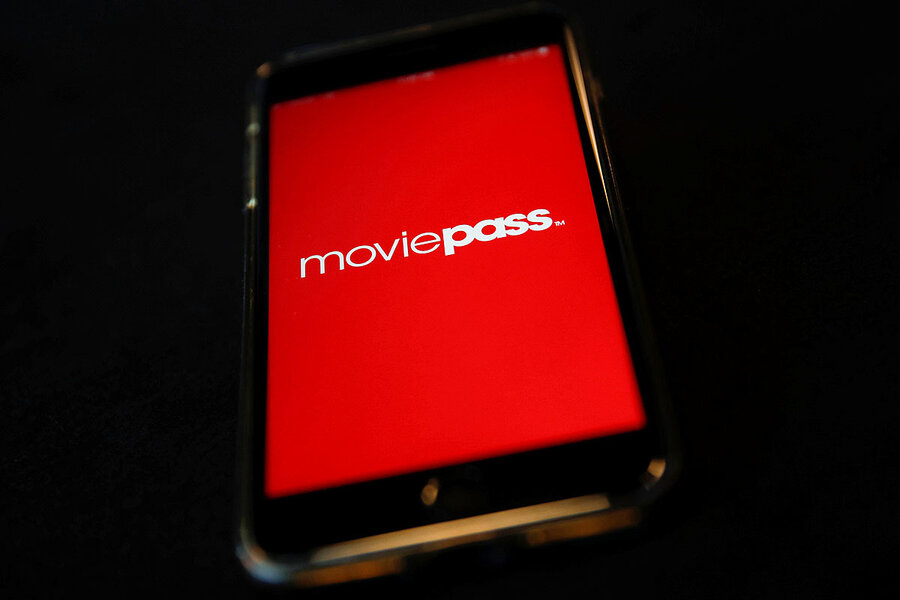In MoviePass morass, lessons about risks, opportunities of industry change
Loading...
By the time you read this sentence, MoviePass could be gone – or completely transformed. That’s how quickly the subscription service is announcing changes to its business model.
Called “Netflix for cinemas,” the service allows users to watch multiple movies per month, for a flat monthly fee. MoviePass aimed to fundamentally change the moviegoing experience with its subscription model. The hope was that viewers would be inclined to see a wider variety of films, not just “tentpole” movies, and that it would force the theater industry to change the way it does business by empowering moviegoers. At its peak, some 3 million people subscribed to the service, but it has recently run into a series of problems that has left many wondering about its viability.
At the end of July, two outages left customers unable to use their debit card-like passes, staring at an app showing no movie times, and tweeting furiously. The company had run out of cash to pay for tickets and needed to take out a $6.25 million loan. The ordeal left its parent company Helios and Matheson Analytics Inc.’s stock closing at 5 cents, suggesting that the market thinks the end of MoviePass is nigh. In 2017, it peaked at $8,225 per share.
Why We Wrote This
MoviePass hoped to fundamentally change the moviegoing experience. A series of problems has put the company in jeopardy, but its bold experiment may help disrupt the movie theater industry.
MoviePass sent out a series of emails apologizing and announcing changes. On July 31, users were told they would not be able to see certain blockbusters in opening weeks and the price would increase from $9.95 a month to $14.95. Then they scrapped those changes, announcing that starting Aug. 15, users could see three movies a month instead of one a day.
On Friday, the service crashed for the third weekend in a row, hours after limiting subscribers to only two films. CEO Mitch Lowe confirmed that users would only be able to choose between two movies a day, saying: “We had to right the ship as far as the amount of money we were burning.”
Multiple law firms have filed or are investigating class action lawsuits on behalf of Helios investors, alleging the company had made false and misleading statements on MoviePass’s valuation and future profitability.
On Aug. 2, MoviePass told users in a press release: “We’re still standing.”
The question is: for how much longer?
Users should swipe their MoviePass cards while they still can, says Emory University marketing professor Daniel McCarthy, who specializes in a new approach to valuing companies by looking at customer behavior.
“They’ve announced or actualized a truly astounding number of changes to their terms,” says Professor McCarthy. “I think it's indicative that management at this stage is going off the seat of their pants and there is not necessarily a whole lot of logic going into some of the changes they’ve made more recently.”
Moviegoing enters the subscription economy
Curtis Medina goes to the movies five to eight times a month with MoviePass, estimating he’s saved up to $3,000 on tickets over the past five years. He still has cautious faith about the service’s future.
“The idea of having a service that no matter how the rest of your life is you can depend on going to see a movie whenever you want is awesome,” says Mr. Medina, a resident of Missoula, Mont., and Myrtle Beach, S.C. Without MoviePass, he says, movies are too expensive for him. Medina says he sees it as a champion for the average moviegoer.
The subscription-service economy has been growing 200 percent annually since 2011, changing everything from music (Spotify) and TV (Netflix) to grooming (Dollar Shave Club) and clothes (Stitch Fix).
“You don’t need to own a car. You don’t need to own movies. You can just tap into services to get what you need…. [Subscription] really changes the economic calculus that you have to put into thinking about what it is that you want,” says Tien Tzuo, the CEO of Zuora, which sells software geared for subscription-based companies.
“We think we’re witnessing the beginning of the end of ownership,” says Mr. Tzuo, who coined the term “subscription economy” in 2007. As industries wade into subscription offerings, failure is to be expected, he adds.
Over the past year, MoviePass has made major policy revisions to its terms of service every other month, frustrating users. It says its constant self-transformation is typical of an industry disruptor. McCarthy says it’s a sign of trouble.
Subscription models for movies have existed for years internationally, mainly run in-house by theaters in Europe. MoviePass, founded in 2011, made headlines in August 2017 when it lowered its monthly unlimited rate to $9.95. Its base grew from about 20,000 at the end of 2016 to more than 3 million as of July 2018.
Can MoviePass spur movie attendance?
US movie attendance has declined since peaking in 2002, according to the National Association of Theater Owners. MoviePass got users to the movies more often, especially during the week and in the middle of the day, and to movies they previously would have passed on. Supporters say people still want the movie theater experience – just not at its current price tag. MoviePass claims that its users represent 6 percent of all US ticket sales.
“We do want to go out,” says Medina. “We do want to see [movies]. We just needed a better business model.... [MoviePass] cuts out the question of whether or not it’s going to be worth it to go out.”
After adjusting for inflation, average ticket prices have slightly increased since the early 1980s, as tracked by the National Association of Theatre Owners. The current national average is $9.16.
MoviePass pays full price for tickets, so if a subscriber sees more than one movie a month at the average cost, the company loses money. McCarthy says MoviePass’s monthly rate is egregiously underpriced and the only option for survival is to raise prices – even at the risk of losing a chunk of its customers.
Movie exhibitors, who blame MoviePass for devaluing tickets, are setting up their own services. In June, AMC announced it would offer its own subscription service, Stubs A-List, at $19.95 a month for any three AMC movies per week. Last November, Cinemark launched its MovieClub service, a loyalty program with one free ticket a month. Sinemia brought its program from Europe to the United States in May, with options ranging from one to three tickets a month.
Margaret Riley, a retired educator who lives in Durham, N.C., became a MoviePass subscriber in 2014, paying $19.95 a month initially and $39.95 at its peak. She now pays $6.95 a month for the yearly plan and sees 10 to 12 movies each month. Eighty-five percent of subscribers see three movies or fewer each month, making Ms. Riley and Medina superusers.
[Editor's note: The original version of this article misstated the price Margaret Riley initially paid for her MoviePass subscription.]
The recent changes to MoviePass frustrate Riley, who paid a year’s membership in advance.
“For those of us who appreciate a good deal, we were willing to muddle through.… If it ends tomorrow, in spite of all the problems, I will say I’ve been glad to have had a MoviePass and I will be sorry if it does go down the tubes,” she says. “For an avid moviegoer like me, it really did provide a service. It might have been flawed, but it was a valuable service for me.”







